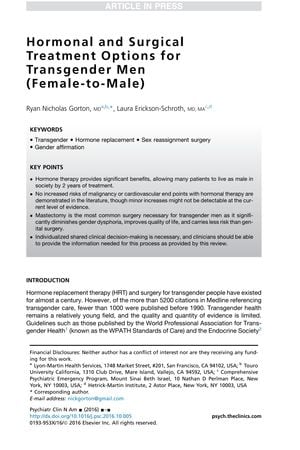Hormonal and Surgical Treatment Options for Transgender Men (Female-to-Male)
December 2016
in “
Psychiatric Clinics of North America
”

TLDR Testosterone therapy and surgeries like mastectomy improve transgender men's lives and mental health with low risks and high satisfaction.
The 2017 document outlines hormonal and surgical treatments for transgender men, emphasizing the effectiveness of hormone therapy with testosterone in enabling patients to live as male within 2 years and the lack of evidence for increased malignancy or cardiovascular risks. Mastectomy is the most common surgery, significantly improving quality of life and reducing gender dysphoria with fewer risks than genital surgery. Hormone therapy mimics male puberty, with effects such as cessation of menses and clitoral growth, and may result in changes in sexual orientation. Testosterone is not a contraceptive, and pregnancies can occur after its use. Fertility preservation options are discussed, with embryo cryopreservation being the most reliable. Cancer risks associated with hormone therapy are not well established, with no definite link found between testosterone and malignancy in transmen. Systemic effects of testosterone include acne, hair and skin changes, and potential impacts on musculoskeletal, hematologic, and pulmonary functions. Regular clinical and laboratory monitoring is recommended. Surgical options can greatly improve mental health, with high satisfaction rates for procedures like mastectomy, metoidioplasty, and phalloplasty. The document concludes that both hormonal and surgical treatments are medically necessary, safe, and effective for improving the mental health and quality of life of transgender men, with low regret rates and decreased suicidality.





